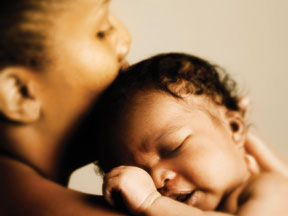Each year around the world 3.6 million infants die in the first 28 days of life. The majority of these deaths occur within seven days of birth and 98 percent occur in developing countries.
But basic newborn care and resuscitation interventions could be implemented in a cost-effective manner at health-care facilities in countries with limited financial resources, according to the findings of study by University of Alabama at Birmingham researchers published online April 18, 2011, in Pediatrics.
 Previous studies have shown that training personnel in first-level facilities and communities in developing countries using basic neonatal care from the World Health Organization Essential Newborn Care course — routine neonatal care, resuscitation, thermoregulation, breastfeeding, kangaroo care, care of the small baby and common illnesses — could save up to 1 million lives each year.
Previous studies have shown that training personnel in first-level facilities and communities in developing countries using basic neonatal care from the World Health Organization Essential Newborn Care course — routine neonatal care, resuscitation, thermoregulation, breastfeeding, kangaroo care, care of the small baby and common illnesses — could save up to 1 million lives each year.
“A major barrier to action on neonatal health has been the erroneous perception that only expensive, highly technological care can reduce mortality,” said study co-author Wally Carlo, M.D., director of the UAB Division of Neonatology. “We have proven through this study that the cost of saving lives is very low – about $200 per child.”
Carlo and his colleagues compared the cost and the outcomes of training midwives who worked in primary care, low-risk health facilities in Lusaka and Ndola, Zambia. The midwives participated in the WHO essential newborn-care course on seven-day neonatal mortality.
They looked at two types of expenses: program-level costs (initial training, training equipment and materials, initial implementation and supervision) and maintenance costs (ongoing supervision, the costs per year for subsequent maintenance of the program). They related these to neonatal mortality in the clinic for both pre-training and post training for the staffs.
A total of 40,615 neonates were enrolled in the study. All-cause seven-day neonatal mortality decreased from 11.5 per 1,000 births before essential newborn-care training to 6.8 per 1,000 births after training; it was associated with a decrease in deaths caused by birth asphyxia and infection. During the post-training period 20,534 neonates survived and did not suffer seven-day early neonatal mortality, reducing neonatal death in Zambia by 40 percent.
“On the basis of this outcome we estimated that a total of 97 lives were saved during the study period, with a cost per life saved of $208,” Carlo said. “The estimated yearly costs to maintain the program, including equipment replacement, training manuals, and personnel was $14,128 per year and cost-effectiveness data like this are needed to guide the development of policies and strategies to accomplish the United Nations’ Millennium Development Goal 4 to reduce childhood mortality by two-thirds by 2015.”
Carlo’s co-authors on the paper are Albert Manasyan, M.D., M.P.H., and Sara Krzywanski, M.S., of UAB; Elwyn Chomba, M.D., of UAB, the Centre for Infectious Disease Research (CIDRZ) and University of Zambia, Lusaka, Zambia; Elizabeth M. McClure, M.Ed., RTI International, Durham, N.C.; and Linda L. Wright, M.D. of the Eunice Kennedy Shriver National Institute of Child Health and Human Development, Bethesda, Md.
This study was funded by grants from the Eunice Kennedy Shriver National Institute of Child Health and Human Development, Global Network for Women’s and Children’s Health Research and the Bill and Melinda Gates Foundation.